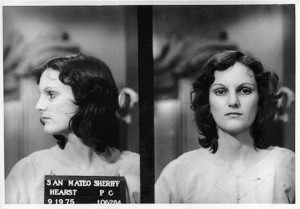Patty Hearst Kidnapping
 The Patty Hearst kidnapping was one of the strangest, most highly-followed kidnapping cases in FBI history. On February 4, 1974, a group of men and women knocked on nineteen-year-old Patty Hearst’s apartment door and proceeded to kidnap her, driving away with Patty stowed in the trunk of their car and beating up her fiancé in the process.
The Patty Hearst kidnapping was one of the strangest, most highly-followed kidnapping cases in FBI history. On February 4, 1974, a group of men and women knocked on nineteen-year-old Patty Hearst’s apartment door and proceeded to kidnap her, driving away with Patty stowed in the trunk of their car and beating up her fiancé in the process.
The group that kidnapped Patty was a radical group of domestic terrorists known as the Symbionese Liberation Army (SLA). This group, led by Donald DeFreeze, was on a mission to destroy the “capitalist state.” They strategically kidnapped Hearst because she was part of a wealthy, powerful family (her grandfather was a famous journalist) and knew that by kidnapping Patty, they would receive a great deal of attention and press.
After Patty’s disappearance, the SLA kept her blindfolded for the next two months at the group’s headquarters. The group soon began to release tapes to the general public that asked for millions of dollars worth of food donations in exchange for her freedom. While Patty’s father initially gave in to these demands, his efforts soon backfired, as the SLA refused to release their hold over Patty.
During the time that Patty was held hostage, the SLA also began to brainwash her, set on turning Hearst into an accomplice for their revolutionary and terrorist goals. Patty was abused both physically and psychologically. She later claimed that she was isolated to the point that she felt that no one would rescue her, and that she was sexually abused by various gang members. Additionally, Patty claimed that she was constantly exposed to the group’s radical beliefs and was forced to record messages that would hurt her loved ones.
These brainwashing methods appeared to be taking effect after the SLA released a tape in which Patty, using her new name “Tania,” claimed that she had joined the SLA’s fight. A few days after the release of this tape, Hearst was spotted taking part in an SLA bank robbery clearly aiding the SLA’s cause. A tape released shortly after the robbery featured Patty explaining that the group members were her comrades, and that their criminal actions were necessary to support the gang’s plans for revolution. Calling her family offensive names, Patty denied vehemently that she was being brainwashed and dismissed such a ridiculous idea, reiterating that she was, “…a soldier of the people’s army.”
Despite Patty’s insistence that she was not brainwashed, and that she was making the choice to support the SLA out of her own free will, many people close to Patty as well as those following her case remained unconvinced, as Patty’s behavior was radically different from how she was before the kidnapping. Some theorize that she fell in love with one of the group’s members (named “Cujo,” whom she mentioned in one of the released videos), while others theorize that she joined the SLA’s mission out of fear, sympathy, or brainwashing.
By this point in the Hearst case, the FBI had launched one of the most massive, agent-intensive searches in its history to find Hearst and stop the SLA in its tracks.
On May 16, 1974, SLA members were caught stealing ammunition from a local store in Los Angeles, California. When Los Angeles police caught up with the gang members at an SLA safehouse, a shootout ensued, sending the entire building up in flames and ultimately causing the deaths of six SLA members.
Although after the fire Hearst promptly fled across the country to avoid capture, FBI agents quickly found her and charged her with bank robbery, among other crimes.
Patty Hearst’s trial was a long and convoluted process, as was the search following her kidnapping. Although F. Lee Bailey, a highly renowned attorney known for having defended Albert DeSalvo (The Boston Strangler) and Sam Sheppard, represented Patty, she was ultimately found guilty by the jury and sentenced to seven years in prison. The jury at the time did not find the theory that she was brainwashed by the SLA plausible, although today Patty Hearst’s case is regarded by many as a clear example of Stockholm Syndrome.
After serving two years in prison, however, President Carter commuted Patty’s sentence, which was later pardoned by President Bill Clinton as one of his final acts in office. Upon Hearst’s release from prison, she went on to become an actress and married her former bodyguard Bernard Shaw, with whom she now has two children.
To learn more about Patty Hearst’s experience through her own eyes, you can check out her book, Patty Hearst: Her Own Story, which was originally titled, Every Secret Thing.
Back to Kidnappings
Back to Crime Library
|
|
|

